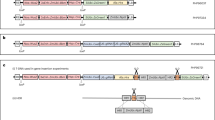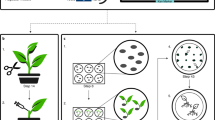Abstract
An optimized protocol has been developed for the efficient and rapid genetic modification of sugar beet (Beta vulgaris L.). A polyethylene glycol-mediated DNA transformation technique could be applied to protoplast populations enriched specifically for a single totipotent cell type derived from stomatal guard cells, to achieve high transformation frequencies. Bialaphos resistance, conferred by the pat gene, produced a highly efficient selection system. The majority of plants were obtained within 8 to 9 weeks and were appropriate for plant breeding purposes. All were resistant to glufosinate-ammonium–based herbicides. Detailed genomic characterization has verified transgene integration, and progeny analysis showed Mendelian inheritance.
This is a preview of subscription content, access via your institution
Access options
Subscribe to this journal
Receive 12 print issues and online access
$209.00 per year
only $17.42 per issue
Buy this article
- Purchase on Springer Link
- Instant access to full article PDF
Prices may be subject to local taxes which are calculated during checkout
Similar content being viewed by others
References
Cooke, D.A. and Scott, R.K. 1993. The sugar beet crop. Chapman and Hall, London, UK.
Winner, C. 1993. History of the crop, pp. 1–36 in The sugar beet crop. Cooke, D.A. and Scott, R.K. (eds.). Chapman and Hall, London, UK.
Steen, P. and Pedersen, H-C. 1993. Gene transfer for herbicide resistance. J. Sugar Beet Res. 30: 267–274.
D'Halluin, K., Bossut, M., Bonne, E., Mazur, B., Leemans, J. and Botterman, J. 1992. Transformations of sugarbeet (Beta vulgaris L.) and evaluation of herbicide resistance in transgenic plants. Bio/Technology 10: 309–314.
Krens, F.A., Trifonova, A., Keizer, L.C.R. and Hall, R.D. 1996. The effect of exogenously-applied phytohormones on gene transfer efficiency in sugarbeet (Bete vulgaris L.). Plant Sci. In press.
Krens, F.A., Zijlstra, C. Van der Molen, W., Jamar, D., and Huizing, H.J. 1988. Transformation and regeneration in sugar beet induced by ‘shooter’ mutants of Agrobacterium tumefaciens. Euphytica 185–194.
Paul, H., Zijlstra, C., Leeuwaugh, J.E., Krens, F.A. and Huizing, H.J. 1987. Reproduction of the beet cyst nematode Heterodera schachtii on transformed root cultures of Beta vulgaris L. Plant Cell Rep. 6: 379–381.
Lindsey, K. and Jones, M.G.K. 1989. Stable transformation of sugarbeet protoplasts by electroporation. Plant Cell Rep. 8: 71–74.
Sangwan, R.S., Bourgeois, Y., Brown, S., Vasseur, G. and Sangwan-Norreel, B. 1992. Characterisation of competent cells and early events of Agrobacterium-mediated genetic transformation in Arabidopsis thaliana . Planta 188: 439–456.
Draper, J., Scott, R. and Hamil, J. 1988. Transformation of dicotyledonous plant cells using the Ti plasmid of Agrobacterium tumefaciens and the Ri plasmid of Agrobacterium rhizogenes, pp. 69–160 in Plant genetic transformation and gene expression: a laboratory manual. Draper, J., Scott, R., Armitage, P., and Walden, R. (eds.). Blackwell, Oxford, UK.
Fry, J.E., Barnason, A.R. and Hinchee, M. 1991. Genotype-independent transformation of sugarbeet using Agrobacterium tumefaciens, in Molecular biology and plant development, Third International Congress of the ISPMB, Tucson, USA. Abstract No. 384.
Sander, U. 1994. Zur Transformation von Beta vulgaris L. PhD Thesis, University of Hannover, Germany.
Kuspa, A. and Loomis, W.F. 1992. Tagging developmental genes in Dictostelium by restriction enzyme-mediated integration of plasmid DNA. Proc. Natl. Acad. Sci. 89: 8803–8807.
Hall, R.D., Verhoeven, H.A. and Krens, F.A. 1995. Computer-assisted identification of protoplasts responsible for rare division events reveals guard cell totipotency. Plant Physiol. 107: 1379–1386.
Hall, R.D., Pedersen, C. and Krens, F.A. 1993. Improvement of protoplast culture protocols for Beta vulgaris L. (sugar beet). Plant Cell Rep. 12: 339–342.
Krens, F.A., Jamar, D., Rouwendal, G.J.A. and Hall, R.D. 1990. Transfer of cytoplasm from new Beta CMS sources to sugar beet by asymmetric fusion. Theor. Appl. Genet. 79: 390–396.
Lenzner, S., Zoglauer, K. and Schieder, O. 1995. Plant regeneration from protoplasts of sugar beet (Bete vulgaris). Physiol. Plant. 94: 342–350.
Benediktsson, I., Spampinato, C. and Schieder, O. 1995. Studies of the mechanism of transgene integration into plant protoplasts: improvement of the transformation rate. Euphytica 85: 53–61.
Hall, R.D., Riksen-Bruinsma, T., Weyens, G.J., Lefebvre, M., Dunwell, J.M., van Tunen, A., et al. 1996. Sugar beet guard cell protoplasts demonstrate a remarkable capacity for cell division enabling applications in stomatal physiology and molecular breeding. J. Exper. Bot. In press.
De Block, M., De Sonville, A. and Debrouwer, D. 1996. The selection mechanism of phosphinothricin is influenced by the metabolic status of the tissue. Planta 197: 619–626.
Sack, F.D. 1987. Development and structure of stomata, pp. 59–89 in Stomatal function. Zeiger, E., Farquhar, G.D., and Cowan, I.R. (eds.). Stanford Univ. Press, Palo Alto, CA.
Melaragno, J.E., Mehrotra, B. and Coleman, A.W. 1993. Relationship between endopolyploidy and cell size in epidermal tissue of Arabidopsis . Plant Cell 5: 1661–1668.
Pospisilova, J. and Santrucek, J. 1994. Stomatal patchiness. Biol. Plant. 36: 481–510.
Mansfield, T.A., Hetherington, A.M. and Atkinson, C.J. 1990. Some current aspects of stomatal physiology. Annu. Rev. Plant Physiol. 41: 55–75.
Krens, F.A., Molendijk, L., Wullems, G.J. and Schilperoort, R.A. 1982. In vitro transformation of plant protoplasts with Ti-plasmid DNA. Nature 296: 72–74.
Struhl, K., Cameron, J.R. and Davis, R.W. 1976. Functional genetic expression of eukaryotic DNA in Escherichia coli . Proc. Natl. Acad. Sci. USA 73: 1471–1475.
De Greef, W. and Jacobs, M. 1979. In vitro culture of sugar beet: description of a cell line with a high regeneration capacity. Plant Sci. Lett. 17: 55–61.
Creemers-Molenaar, J., Loeffen, M., van Rossum, M., and Colijn-Hooymans, C.M. 1992. The effect of cold storage and ploidy level on the morphogenic response of perennial ryegrass (Lolium perenne) suspension cultures. Plant Sci. 83: 87–94.
Kramer, C., DiMaio, J., Carswel, G.K. and Shillito, R.D. 1993. Selection of transformed protoplast-derived Zea mays colonies with phosphinothricin and a novel assay using the pH indicator chlorophenol red. Planta 190: 454–458.
Alexander, M.P. 1969. Differential staining of aborted and non-aborted pollen. Stain Technol. 44: 117–122.
Author information
Authors and Affiliations
Rights and permissions
About this article
Cite this article
Hall, R., Riksen-Bruinsma, T., Weyens, G. et al. A high efficiency technique for the generation of transgenic sugar beets from stomatal guard cells. Nat Biotechnol 14, 1133–1138 (1996). https://doi.org/10.1038/nbt0996-1133
Received:
Accepted:
Issue Date:
DOI: https://doi.org/10.1038/nbt0996-1133
This article is cited by
-
Isolation of high purity guard cell protoplasts of Arabidopsis thaliana for omics research
Plant Growth Regulation (2019)
-
Plant regeneration from protoplasts in Indian local Coriandrum sativum L.: scanning electron microscopy and histological evidences for somatic embryogenesis
Plant Cell, Tissue and Organ Culture (PCTOC) (2014)
-
Embryogenic responses of Beta vulgaris L. callus induced from transgenic hairy roots
Plant Cell, Tissue and Organ Culture (PCTOC) (2010)
-
Modification of gibberellin signalling (metabolism & signal transduction) in sugar beet: analysis of potential targets for crop improvement
Transgenic Research (2009)
-
Efficient somatic embryogenesis in sugar beet (Beta vulgaris L.) breeding lines
Plant Cell, Tissue and Organ Culture (2008)



